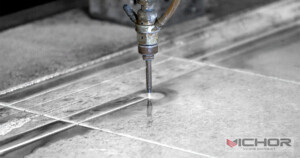
7 Reasons Abrasive Waterjet Services Are a Manufacturing Powerhouse
In the ever-evolving world of manufacturing and fabrication, the quest for a cutting method that combines precision, versatility, and power is never-ending. Among the myriad of technologies available, one stands out for its unique ability to handle an astonishing array of materials with unparalleled cold-cutting precision: abrasive waterjet services. This technology harnesses the raw force of nature, mixing high-pressure water with abrasive garnet to slice through virtually any material known to man. For engineers, designers, and fabricators, understanding the capabilities of professional abrasive waterjet services is key to unlocking new possibilities in production. This article delves into seven core aspects that make this technology an indispensable asset in modern industry.
What Exactly Are Abrasive Waterjet Services?
At its core, an abrasive waterjet is an advanced tool that uses a supersonic stream of water mixed with fine particles of an abrasive substance, typically garnet. The process begins with a high-pressure pump that intensifies regular water to pressures exceeding 60,000 PSI (and often reaching 90,000 PSI). This ultra-high-pressure water is then focused through a small orifice, typically made of diamond or sapphire, creating a pure waterjet.
For cutting harder materials, this stream is then fed into a mixing tube, where the abrasive garnet is introduced. The water accelerates these abrasive particles, creating an erosive, saw-like action that cuts through the material. Companies that provide abrasive waterjet services operate these sophisticated machines, offering cutting as a service to clients who require high-precision parts without the capital investment of owning the machinery themselves.
Unmatched Material Versatility: Cutting Almost Anything
Perhaps the most significant advantage of utilizing abrasive waterjet services is their incredible material versatility. Unlike thermal cutting processes like laser or plasma, which are limited by a material’s reflectivity or conductivity, waterjet cutting is a mechanical process. This means it is entirely material-agnostic.
A single abrasive waterjet services provider can seamlessly switch between jobs involving:
Metals: From soft aluminum and copper to hardened tool steel, titanium, and exotic alloys.
Stone and Tile: Perfect for intricate designs in marble, granite, and glass for architectural features.
Composites: Ideal for cutting carbon fiber, fiberglass, and Kevlar without delamination or fraying.
Plastics and Polymers: Cuts through acrylic, polycarbonate, and rubber without melting or releasing toxic fumes.
Laminated Materials: Excellently cuts through materials with different layers, like kitchen countertops, without separation.
This one-stop-shop capability makes abrasive waterjet services a go-to solution for projects requiring multiple materials.
The Pinnacle of Precision and Complex Geometry
When a project demands extreme accuracy and the ability to produce complex shapes, abrasive waterjet services deliver. The stream diameter, or kerf width, is typically between 0.02″ and 0.05″ (0.5mm to 1.3mm), allowing for exceptionally fine detail and tight nesting of parts to minimize material waste.
The computer-controlled (CNC) nature of the process means it can follow any digital design path with incredible accuracy, typically holding tolerances within ±0.005″ (±0.13 mm). This allows for the production of intricate patterns, sharp corners, and detailed geometries that would be impossible or prohibitively expensive with other mechanical methods like milling or routing. For industries like aerospace and medical device manufacturing, where complex, precision parts are the norm, this level of accuracy is non-negotiable.
The Cold Cutting Advantage: Preserving Material Integrity
A critical benefit that sets abrasive waterjet services apart from thermal cutting methods is the absence of heat. Lasers, plasma cutters, and oxy-fuel torches generate intense heat to melt or burn through material. This Heat-Affected Zone (HAZ) can alter the material’s properties, creating hardened edges, micro-fractures, or thermal distortion.
Waterjet cutting is a cold process. The cutting action occurs through erosion, not melting, which means:
No Heat-Affected Zone (HAZ): The material’s inherent structure and temper remain unchanged.
No Warping or Distortion: Thin materials, which are highly susceptible to heat, remain perfectly flat.
No Toxic Fumes: Cutting plastics or coated metals with heat can vaporize harmful chemicals. Waterjet produces no harmful byproducts, making it safer and more environmentally friendly.
This cold-cutting capability is essential for materials that are sensitive to heat, such as tempered glass, certain alloys, and explosives.
Superior Edge Quality and Minimal Secondary Processing
The edge quality produced by a high-quality abrasive waterjet services operation is another major selling point. While a slight tapered edge (wider at the top than the bottom) is characteristic of the process, advanced machines and skilled operators can minimize this effect. Furthermore, the edge is typically a smooth, satin finish.
For many applications, the edge straight from the waterjet is acceptable for the final product, eliminating the need for time-consuming and costly secondary finishing processes like grinding or milling. When an even finer finish is required on thicker materials, operators can use specialized cutting heads or reduce the cutting speed to enhance the surface finish, providing flexibility based on the project’s requirements and budget.
Efficiency, Speed, and Cost-Effectiveness
While not always the absolute fastest cutting method for thin sheet metal, abrasive waterjet services offer a unique blend of speed and cost-effectiveness when considering the entire production workflow. There is no setup time for tooling; the machine simply follows a new digital file. This makes it perfect for both low-volume prototype runs and high-volume production.
The ability to nest parts extremely close together dramatically improves material utilization, reducing scrap and saving money on expensive materials. When you factor in the elimination of secondary finishing, reduced inspection time due to high accuracy, and the ability to cut virtually any material on a single platform, the total cost of ownership for parts produced through abrasive waterjet services is often highly competitive.
Environmental and Safety Benefits
In an increasingly eco-conscious world, the operational benefits of waterjet cutting are noteworthy. The process uses water and natural abrasive garnet (a non-toxic mineral), which can often be recycled within the system or sourced sustainably. It does not produce hazardous waste or release volatile organic compounds (VOCs) into the atmosphere.
From a safety perspective, the process contains the high-pressure stream within the cutting tank, protecting operators. The absence of UV radiation (from lasers) or intense brightness (from plasma) also reduces the need for the specialized safety enclosures required by other cutting technologies.
Abrasive waterjet services have cemented their role as a foundational, versatile, and powerful solution in the manufacturing landscape. Their unique combination of versatility, precision, cold-cutting operation, and material efficiency makes them an invaluable resource for innovators across all sectors. Whether you’re an architect designing a complex metal facade, an aerospace engineer machining a titanium component, or an artist creating a detailed sculpture, partnering with a professional abrasive waterjet services provider can transform your designs into reality with strength and perfection. By leveraging this technology, businesses can push the boundaries of what is possible, ensuring their projects are completed to the highest standard of quality and precision.
continue reading
Related Posts
- 1371 words6.9 min read
- 1449 words7.3 min read



